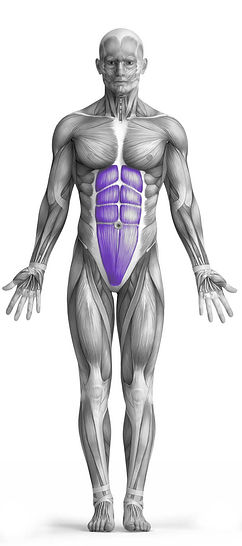Ab Crunch Machine 101 Video Tutorial
0

Exercise Synopsis
Target Muscle Group
Abs
Secondary Targets
Execution
Isolation
Force Type
Core
Required Equipment
Crunch Machine
Fitness Level
Intermediate
Variations
Alternatives
Timer
Hour
Minute
Second
Stopwatch
00:00:00:00
Overview
The Ab Crunch Machine is a popular exercise designed to strengthen the abdominal muscles, primarily targeting the rectus abdominis. Utilizing a specialized Crunch Machine, individuals sit in a reclined position with their feet secured under pads and their hands gripping handles or pads provided by the machine. By contracting the abdominal muscles, individuals perform a crunching motion, bringing their torso towards their thighs against resistance. This movement effectively engages the abs, facilitating muscle development and enhancing core strength. Additionally, the exercise may also engage the lower back muscles as secondary targets, contributing to overall core stability and spinal support.
How to Perform
Sit down on the Ab Crunch Machine with your feet securely positioned under the provided pads and your hands gripping the handles or pads.
Adjust the machine settings to ensure a comfortable starting position and proper alignment of the body.
Contract your abdominal muscles to initiate the movement, exhaling as you crunch your torso towards your thighs.
Maintain control throughout the motion, focusing on squeezing the abs at the top of the movement.
Inhale as you slowly return to the starting position, allowing the abdominal muscles to stretch.
Avoid using momentum or swinging motions to perform the exercise, as this reduces the effectiveness of the movement and increases the risk of injury.
Keep your lower back supported and avoid overarching or hyperextending it during the exercise to prevent strain.
Perform the exercise with a controlled tempo and focus on quality repetitions rather than quantity.
Adjust the resistance level of the machine as needed to ensure a challenging yet manageable workout for the abdominal muscles.
Incorporate the Ab Crunch Machine into your regular routine to strengthen the abs and improve core stability, complementing other exercises targeting the abdominal and lower back muscles for a balanced workout regimen.
★ Bonus: For exercises that involve external weights (such as dumbbells, barbells, or machines), the One Rep Max (1RM) calculator can help you estimate your maximum lifting capacity. Use it to track your strength progress and adjust your training for optimal results.
Tips
Adjust the Ab Crunch Machine to fit your body size and ensure proper alignment.
Sit on the machine with your feet securely placed under the provided pads.
Grip the handles or pads with your hands, maintaining a comfortable position.
Contract your abdominal muscles to initiate the movement, exhaling as you crunch your torso forward.
Focus on squeezing your abs at the top of the movement to maximize muscle engagement.
Keep your lower back supported and avoid overarching during the exercise.
Avoid using momentum or swinging motions to perform the crunches.
Inhale as you slowly return to the starting position, allowing your abs to stretch.
Perform the exercise with a controlled tempo, emphasizing quality over quantity.
Gradually increase the resistance or repetitions as your strength improves to continue challenging your abdominal muscles effectively.
How Not to Perform
Avoid using excessive weight: Select a resistance level that allows you to maintain proper form and control throughout the exercise.
Do not arch your back: Keep your lower back flat against the machine's pad throughout the movement to prevent strain and injury.
Avoid using momentum: Resist the urge to swing your body or use jerking motions to perform the crunches. Focus on controlled movements to maximize muscle engagement.
Do not pull on your neck: Avoid placing your hands behind your head and pulling on your neck to lift your torso. This can strain the neck muscles and detract from the focus on the abs.
Avoid locking out your elbows: Keep a slight bend in your elbows throughout the movement to maintain tension on the abs and prevent strain on the elbow joints.
Do not round your shoulders: Keep your shoulders relaxed and away from your ears during the exercise. Rounding the shoulders can lead to improper form and reduce the effectiveness of the crunches.
Avoid lifting your hips: Keep your hips firmly planted on the machine's pad throughout the movement. Lifting your hips can disengage the abs and shift the focus away from the target muscle group.
Do not hold your breath: Remember to breathe steadily throughout the exercise, exhaling as you crunch your torso forward and inhaling as you return to the starting position. Holding your breath can increase blood pressure and reduce oxygen flow to the muscles.
Avoid overextending your range of motion: Only crunch your torso forward until you feel a strong contraction in your abs. Going too far can strain the lower back and lead to injury.
Do not neglect proper form: Focus on quality over quantity and maintain proper form throughout each repetition. This will ensure that you are effectively targeting the abs and minimizing the risk of injury.
Variations
Variations of fitness exercises refer to different ways of performing a specific exercise or movement to target various muscle groups, intensities, or goals. These variations aim to challenge the body differently, prevent plateaus, and cater to individuals with varying fitness levels.
Alternatives
Alternative exercises in fitness refer to different movements or activities that target similar muscle groups or serve the same training purpose as the primary exercise. These alternative exercises can be used as substitutes when the original exercise is unavailable or challenging to perform due to various reasons such as equipment limitations, injuries, or personal preferences.








